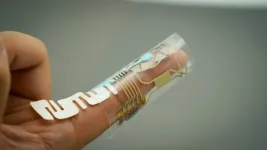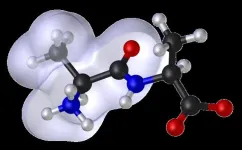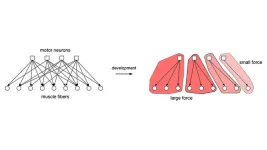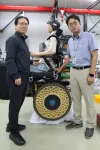(Press-News.org) A sweat-powered wearable has the potential to make continuous, personalized health monitoring as effortless as wearing a Band-Aid. Engineers at the University of California San Diego have developed an electronic finger wrap that monitors vital chemical levels—such as glucose, vitamins, and even drugs—present in the same fingertip sweat from which it derives its energy.
The advance was published Sept. 3 in Nature Electronics by the research group of Joseph Wang, a professor in the Aiiso Yufeng Li Family Department of Chemical and Nano Engineering at UC San Diego.
The device, which wraps snugly around the finger, draws power from an unlikely source—the fingertip’s sweat. Fingertips, despite their small size, are among the body’s most prolific sweat producers, each packed with over a thousand sweat glands. These glands can produce 100 to 1000 times more sweat than most other areas of the body, even during rest. This constant trickle of natural perspiration—without any stimuli or physical activity—offers a reliable energy source, fueling the device even during periods of inactivity or sleep.
The device is constructed from several electronic components printed onto a thin, flexible and stretchable polymer material. Its design allows it to conform to the finger while being durable enough to withstand repeated bending, stretching and movement. “It is based on a remarkable integration of energy harvesting and storage components, with multiple biosensors in a fluidic microchannel, along with the corresponding electronic controller, all at the fingertip,” said Wang.
Central to its operation are biofuel cells that are positioned where the device contacts the fingertip. These cells have been specially engineered to efficiently collect and convert chemicals in sweat into electricity. This electricity is stored in a pair of stretchable, silver chloride-zinc batteries, which power a suite of sensors—four in total—each tasked with monitoring a specific biomarker: glucose, vitamin C, lactate and levodopa, a drug used for treating Parkinson’s disease. As sweat is wicked through tiny paper microfluidic channels to these sensors, the device analyzes the biomarker levels, all while drawing energy it needs from the very sweat it’s sampling. A small chip processes signals from the sensors and wirelessly transmits the data via Bluetooth low energy to a custom-designed smartphone or laptop application.
“This is automatic health monitoring at your fingertips,” said study co-first author Shichao Ding, a postdoctoral researcher in Wang’s research group at the UC San Diego Jacobs School of Engineering. “The wearer can be resting or asleep, and the device can still harvest energy and track biomarker levels.”
In tests, a subject wore the device throughout the day to track glucose levels during meals, lactate levels during both desk work and exercise, vitamin C levels while drinking orange juice, and levodopa levels after eating fava beans, a natural source of the compound.
Ding and co-first author Tamoghna Saha say that the device can be customized to cater to individual health needs by detecting different sets of biomarkers. The researchers are working on developing a closed-loop system that not only monitors biomarkers, but also administers treatments based on the collected data. For instance, in the case of diabetes, such a device could continuously monitor glucose levels and automatically deliver insulin as needed, then assess the treatment’s effectiveness by further monitoring biomarker levels.
“Autonomous power, sensing and treatment all in one device—that’s the ultimate goal,” said Ding.
END
Finger wrap uses sweat to provide health monitoring at your fingertips—literally
2024-09-03
ELSE PRESS RELEASES FROM THIS DATE:
Large sharks may be hunting each other – and scientists know because of a swallowed tracking tag
2024-09-03
Who killed the pregnant porbeagle?
In a marine science version of the game Cluedo, researchers from the US have now accused a larger shark, with its deciduous triangular teeth, in the open sea southwest of Bermuda. This scientific whodunnit is published in Frontiers in Marine Science.
“This is the first documented predation event of a porbeagle shark anywhere in the world,” said lead author Dr Brooke Anderson, a former graduate student at Arizona State University.
“In one event, the population not only lost a reproductive female that could contribute to population growth, but it also lost all her developing ...
Can’t stop belching? Dietary habits or disease could be the reason
2024-09-03
Belching is a common bodily function, but when it escalates to a level that interferes with daily life, it is defined as belching disorders. International surveys have reported that approximately 1% of adults have belching disorders, but the percentage in Japan and the factors involved often elude medical professionals.
To examine the relationship between the rate of belching disorders, comorbidities, and lifestyles in Japan, a research team led by Professor Yasuhiro Fujiwara of Osaka Metropolitan University’s Graduate School of Medicine ...
Exploring peptide clumping for improved drug and material solutions
2024-09-03
Scientists from China have investigated how short peptide chains aggregate together in order to deepen our understanding of the process, which is crucial for drug stability and material development. Their study, published in JACS Au, provides valuable insights into how short proteins called peptides interact, fold, and function. These findings have significant implications for medicine, material science, and biotechnology.
Peptides are short chains of amino acids that play essential roles in the body by building structures, speeding up chemical reactions, and supporting our immune system. The specific function of a protein is determined by how its amino acids interact with each other and ...
Young adults let down by ‘postcode lottery’ for ADHD treatment - national survey
2024-09-03
A national survey conducted as part of University of Exeter research has found huge variation in treatment for ADHD, highlighting the struggle many young adults face once they turn 18.
Researchers have warned that the current system is failing many young adults as they transition from children’s to adult’s services - suddenly finding themselves unable to access treatment because services do not link up effectively.
More than 750 people from across the country – including commissioners, healthcare professionals working ...
False-positive mammography result may discourage women from subsequent screening
2024-09-02
Embargoed for release until 5:00 p.m. ET on Monday 2 September 2024
Annals of Internal Medicine Tip Sheet
@Annalsofim
Below please find summaries of new articles that will be published in the next issue of Annals of Internal Medicine. The summaries are not intended to substitute for the full articles as a source of information. This information is under strict embargo and by taking it into possession, media representatives are committing to the terms of the embargo not only on their own behalf, but also on behalf of the organization they represent.
----------------------------
1. ...
False-positive mammograms discourage some women from future screenings
2024-09-02
Early detection of breast cancer through mammography screening continues to save lives. However, abnormal findings on mammograms can lead to women being recalled for additional imaging and biopsies, many of which turn out to be “false positives,” meaning they do not result in a cancer diagnosis. False positives can also have financial implications for patients and cause significant emotional anxiety.
A major, new study led by the UC Davis Comprehensive Cancer Center has found that women who received a false-positive result that required additional imaging or biopsy were less likely to return ...
The nervous system’s matchmaker
2024-09-02
When you ask a rideshare app to find you a car, the company’s computers get to work. They know you want to reach your destination quickly. They know you’re not the only user who needs a ride. And they know drivers want to minimize idle time by picking up someone nearby. The computer’s job, says Cold Spring Harbor Laboratory Associate Professor Saket Navlakha, is to pair drivers with riders in a way that maximizes everyone’s happiness.
Computer scientists like Navlakha call this bipartite matching. It’s the same task handled by systems pairing organ donors with transplant candidates, medical students with residency ...
Open Wide: Human Mouth Bacteria Reproduce through Rare Form of Cell Division
2024-09-02
By Emily Greenhalgh
One of the most diverse ecosystems on the planet is closer than you think — right inside your mouth. Your mouth is a thriving ecosystem of more than 500 different species of bacteria living in distinct, structured communities called biofilms. Nearly all of these bacteria grow by splitting [or dividing] into two, with one mother cell giving rise to two daughter cells.
New research from the Marine Biological Laboratory (MBL) and ADA Forsyth uncovered an extraordinary mechanism of cell division in Corynebacterium matruchotii, one of the most common bacteria living in dental plaque. ...
KIMM develops wheel that alters stiffness in real time based on situation
2024-09-02
A new technology for wheels and mobile systems, necessary for overcoming various obstacles in daily life such as stairs or rocks by adjusting the stiffness of the wheel in real time, has been developed for the first time in the world. This noble technology is anticipated to find wide applications in various moving vehicles equipped with wheels, where overcoming terrain obstacles is essential.
The Korea Institute of Machinery and Materials (President Seog-Hyeon Ryu, hereinafter referred to as KIMM), an institute under the jurisdiction of the ...
Blood stem cell breakthrough could transform bone marrow transplants
2024-09-02
Melbourne researchers have made a world first breakthrough into creating blood stem cells that closely resemble those in the human body. And the discovery could soon lead to personalised treatments for children with leukaemia and bone marrow failure disorders.
The research, led by Murdoch Children’s Research Institute (MCRI) and published in Nature Biotechnology, has overcome a major hurdle for producing human blood stem cells, which can create red cells, white blood cells and platelets, that closely match those in the human embryo.
MCRI Associate Professor Elizabeth Ng said the team had made a significant discovery in human blood stem ...






